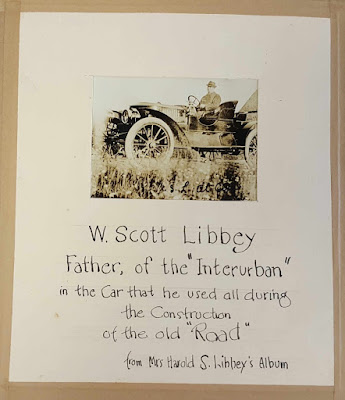Family members seated in W. S. Libbey's 1908
Stanley Motor Coach Company, K 30-hp Semi-Racer.
L-R, daughter, Alla Libbey, Mrs. W. S. "Annie" Libbey, and
son, W. S. "Scott" Libbey, Jr. - W. S. Libbey, Sr.
was most likely the photographer. Circa 1910
Photo courtesy of Mary Libbey Conley
(daughter of W. S. "Scott" Libbey, III) via Paul Libbey
(son of W. S. "Scott" Libbey, Jr.)
W. S. Libbey, the intrepid builder of the Portland-Lewiston Interurban, the "Finest and Fastest Electric Railroad in All New England", was a beloved father, a prominent Lewiston financier, and businessman, with a generous heart. He had a zest for life, relentless energy, and indomitable will. So, it was fitting to purchase a motor vehicle in 1908 that exemplified many of those endearing characteristics.
Hear More About W. S. Libbey's Stanley K Semi-Racer - July 21, 2017
at the 2017 Teddy Roosevelt Days opening gala - details below
at the 2017 Teddy Roosevelt Days opening gala - details below
W. Scott Libbey driving his 1908 Stanley Steamer K 30-hp
Semi-Racer. Mr. Libbey would drive his Stanley while inspecting
the excavation and construction of the
Portland-Lewiston Interurban line (1910-1914). This page is
from the large "Interurban" Scrapbook
made to commemorate the employees of the
Portland-Lewiston Interurban. PWM image
W. S. Libbey - depicted in a
caricature from the book,
"Men of the Hour". Notice his Stanley :)
Courtesy of DigitalMaine.com
"Quite Likely The Most Valuable Stanley in the World"
W. S. Libbey's 1908 Stanley stayed in the Libbey family for generations. It is now part of the Richard C. Paine, Jr. Automobile Trust and resides in the collection of the Seal Cove Auto Museum on Mount Desert Island, Maine.
The Seal Cove Auto Museum's website has this to say about the Stanley:
Provenance: "The Stanley Model K Semi-Racer is one of three remaining of the 25 built by Stanley from 1906-1908. While the other two have been restored, this one is in its original condition. It is thus of exceptional value, quite likely the most valuable Stanley in the world. Plans to preserve this car include full reassembly while preserving what makes it so original."
W. Scott Libbey's 1908 Stanley Steamer K 30-hp Semi-Racer at the
2014 Pebble Beach Concours d'Elegance in California. The permanent home
of this very rare car is at the Seal Cove Auto Museum in
Mount Desert Island (MDI) in Maine.
A total of twenty-five of these cars were built in 1906 and 1908 combined.
Image courtesy of Seal Cove Auto Museum
Hear More About W. S. Libbey's Stanley K Semi-Racer - July 21, 2017
And....see Libbey's beloved 1912 "Narcissus" from the Portland-Lewiston Interurban
Theodore Roosevelt was a passenger on the Narcissus on August 18, 1914, as he traveled from Lewiston to Portland on the Portland-Lewiston Interurban
And....see Libbey's beloved 1912 "Narcissus" from the Portland-Lewiston Interurban
Theodore Roosevelt was a passenger on the Narcissus on August 18, 1914, as he traveled from Lewiston to Portland on the Portland-Lewiston Interurban
One of the presenters on the schedule for the Friday gala opening is Mr. Roberto Rodriguez. Mr. Rodriguez is the Director of Curatorial Affairs at the Seal Cove Auto Museum on Mount Desert Island in Maine. Mr. Rodriguez will present a short history of the Stanley Brothers Company and their land record speed holding Stanley from the early 1900s, as well as discuss the very rare W. S. Libbey Stanley Steamer K 30-hp Semi-Racer that is included in the Museum's extensive collection of automobiles.
Wade Zahares, the Maine artist, will also be a presenter at, Friday, July 21st opening gala. Wade will be unveiling his beautiful original artwork depicting the historic Portland-Lewiston Interurban, Narcissus, operating on the rails alongside the indomitable builder of the PLI, W.S. Libbey, driving his 1908 K Semi-Racer!
~~~~~~~~~~~~~~~
We continue the restoration work on the 1912 Narcissus, the only surviving high-speed, luxury interurban coach of the Portland-Lewiston Interurban.
Click Here: Narcissus Restoration-Related Posts
Being more than a century old, the stately, "Elegant Ride," Narcissus, is a gem. This shimmering precious stone of Maine transportation history is brilliantly resplendent as it emanates so many elements of history, including; time, places, people, and events, that it was coupled to, that when just a smattering of its seemingly innumerable stories are shared, the contents captivates, fascinates, then generates, interest to learn more 🙋. The majestic Narcissus is listed in the National Register of Historic Places.
Please consider joining the epic journey to complete the Narcissus Project by making a donation today!
Click Here: Donation Options
The restoration of this majestic icon of Maine's electric railway history is but one in a series of captivating stories containing an abundance of incredible coalition of narratives.
Click Here: History-Related Posts - Narcissus and Portland-Lewiston Interurban
The Narcissus is featured in the national Gold Award-winning novel, Teddy Roosevelt, Millie, and the Elegant Ride. The "Elegant Ride" is the Narcissus. Theodore Roosevelt was a passenger on the Narcissus on August 18, 1914, between Lewiston and Portland, Maine, while campaigning for the Progressive Party candidates.
Click Here: Bookstores and Businesses promoting the Narcissus Project
Independent book publisher Phil Morse, holding
Gold Book Award Winner plaque for
Middle Reader category for The Eric
Hoffer Book Award. Congratulations to
award-winning Maine author,
Jean M. Flahive






















